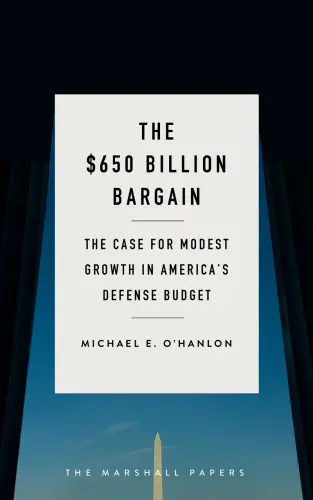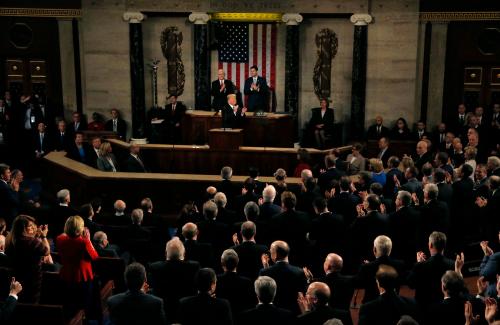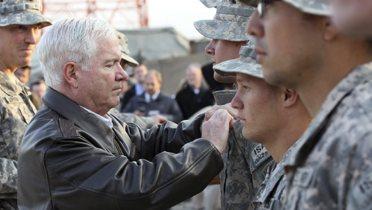President Trump’s partial budget request to Congress, aimed at enhancing American national power, equates national power only with military strength and border security, write Michael O’Hanlon and Alice Rivlin. This narrow definition ignores that America’s power depends fundamentally on rising American prosperity and our ability to build strong coalitions of nations. This piece originally appeared in The Hill.
Earlier this month, President Trump submitted a partial budget request to Congress, aimed at enhancing American national power. Unfortunately, the budget equates national power only with military strength and border security.
This narrow definition ignores the obvious fact that America’s power depends even more fundamentally on rising American prosperity and our ability to build strong coalitions of nations to help us reduce violence and enhance mutual prosperity.

Indeed, by defining American power so narrowly and paying for its spending increases with cuts in international operations and a narrow range of domestic appropriations that would otherwise enhance future economic growth, this budget risks weakening America’s strength and ability to lead.
The Trump budget proposal has been called the “Hard Power Budget” because it proposes to increase military spending, including the nuclear programs in the Department of Energy, by $54 billion relative to currently enacted spending, or about 10 percent. (The actual increase would be only about half that relative to recent years. This year’s budget is at present incomplete and thus not the best reference point.) It also adds to funding for homeland security, especially on the southern border, and veterans’ affairs.
A reasonable case can be made for additional spending on the armed forces, border security, and veterans—a case which we will not examine here. But proposed offsetting cuts in other parts of the budget will reduce America’s security and standing in the world.
One big risk comes from the deep cuts the Trump budget makes in funding for international activities, sometimes called “soft power.” Many of the risks we face in the world have major cross-border dimensions. They include terrorism, weapons of mass destruction in the hands of rogue regimes or terrorists, mass migrations resulting from drought and violence, and biological weapons or natural outbreaks of disease.
Reducing those risks requires allies and coalitions, which means diplomacy and in some cases aid and support for weaker partners. Military leaders, from former Secretary of Defense Robert Gates to General John Allen to General David Petraeus and many others, have underscored this basic reality.
Even more important, but much less commonly discussed in these terms, the essential element of long-term U.S. power and influence is a growing economy that generates a rising standard of living and sufficient public resources to cope with risks and problems at home and abroad. Higher economic performance requires investing in future productivity growth by supporting and enabling scientific research, skill development, and modernization of infrastructure, especially transportation
We can certainly argue about the best way to do that—and about the optimal roles of federal government versus states and the private sector. But the domestic appropriations that President Trump targets for spending cuts to offset his proposed increases in hard power are precisely the budget accounts focused on increasing future economic strength and prosperity.
President Trump is right that funding a hard-power build-up by adding to our already large and growing national debt is unwise. But doing so by undercutting the government’s ability to provide its citizens with basic services and invest in future economic growth is even worse.
The Trump partial budget deals only with the funds appropriated annually by Congress, sometimes called “discretionary spending,” to distinguish it from spending for interest on the debt and for entitlement programs, such as Social Security and Medicare, mandated by ongoing legislation. All discretionary spending is now just over 30 percent of total federal spending.
The Trump budget does not even consider paying for the increases in hard power by reducing the growth of future entitlements, which are much larger and projected to grow faster than appropriations. These programs are very important to our growing elderly population and disabled and other vulnerable Americans, but contribute less to national strength and future growth than do “discretionary” accounts. Nor does the Trump budget consider the possibility that a country with commitments to an aging population and a growing debt should raise more revenue.
In thinking about the Trump administration’s budget proposal, it is useful to put spending into three categories. The first would be defense and other “hard power,” currently about $650 billion (without counting war supplementals). This category includes the budget for the Department of Defense and nuclear weapons part of the Department of Energy, the Department of Homeland Security, and services to veterans (mostly for hospitals). The Trump administration proposes to increase this part of the budget by about $61 billion or just over nine percent.
The second is international affairs—currently about $38 billion, again not counting supplementals. This includes the State Department, U.S. participation in international organizations, and U.S. economic aid to other countries. All together, these tools of foreign policy cost less than one-tenth what our military does, but the Trump budget would cut these accounts by about $11 billion, or about 29 percent. Precipitous cuts of such magnitude risk crippling U.S. efforts to build strong relations with allies and to stabilize war-torn areas after military operations end.
The third category is domestic appropriations, currently about $380 billion. Funding for all these domestic activities has been cut in recent budgets and amounts to about one-tenth of all federal spending, or just over 2 percent of gross domestic product (GDP). A further 14 percent cut, as proposed in the Trump budget, would take spending below its lowest level relative to the size of the economy in more than 50 years.
This broad category includes all the basic services of government, such as the federal role in law enforcement, federal courts, and managing public buildings, national parks and public lands and forests. It also includes many activities that strengthen the economy and enhance future productivity in various ways. It includes funding for scientific research, including biomedical research, and space exploration, as well as health programs (other than Medicare and Medicaid) that fund public health activities such as monitoring for pandemics and keeping food safe.
It includes federal funding for transportation—highways and airports, air traffic control—which the Trump budget cuts despite presidential candidate Donald Trump’s advocacy of a huge infrastructure modernization program. It also includes programs to protect the air we breathe and water we drink—and thus the health and economic productivity of the American workforce. It encompasses programs to conserve agricultural land and enhance agricultural productivity. It includes funding for education, training, and related efforts to increase the skills of the current and future workforce.
We are not defending every federal program or supporting all the above efforts with equal fervor and funding. There are low priority and less effective programs in the domestic appropriations category, as there are in hard power and international affairs. These should be pared back in favor of more effective ones.
Rather, our point is this: if you are in favor of a strong America, don’t think in terms of “national defense” and “non-defense” discretionary budgets. Think in terms of hard power, international affairs, and domestic appropriations. Don’t waste money on any of them. But remember that American power involves a lot more than military spending and secure borders.









Commentary
Trump must recognize that national power goes beyond the military
April 4, 2017